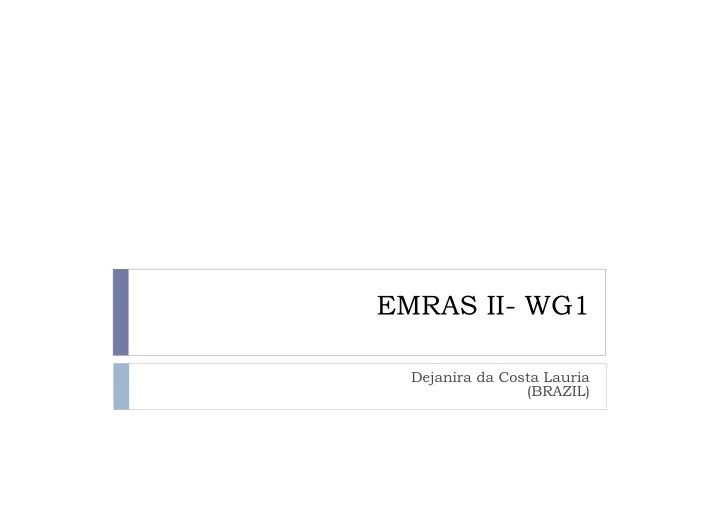

EMRAS II- WG1 Dejanira da Costa Lauria (BRAZIL)
Scenario A version 2 • CROM code based on SRS 19 (screening code) • The code is a beta version-attempt to run it and to inform CIEMAT the problems we have met. • Some improvements were done. but there is still place to improve. • A group of study was created consisting of people from the Reactors. Regulatory Authority and Technical Service Office. • GEN II code was bought
Reported Results Total concentration in water & Dissolved concentration in water; Concentration in suspended sediment Concentration in bottom sediment (Csb) Concentration in shoreline sediment (Css) Css=60*Csb
Nuclear Power Plants at Angra dos Reis CNAAA unit 1 (Angra 1) -Westinghouse 600 Mwe: it started operation in 1982 CNAAA unit 2 (Angra 2)- KWU 1300 Mwe;Operation started in 2000 4
Discharge Channel Liquid effluent discharge is not continuous Meteorological data are integrated and are directly put in the dose codes (online monitoring)
Which scenario should we choose? • Angra nuclear power plant scenario . – No homogeneous human group was identified. – Four age groups are considered: – Child (0-7years). Child (7-12 years). Adolescent (12-17 years) and Adult (>17 years) – For each age group: the habits and consumption rates are from the most exposure individuals (95% percentile of the distribution of consumption rate of local products and the spent time on the beach) – Location of the groups: 1000 meters from the reactor site – Individual age group doses are reported
Exposure pathways • Atmosphere Radionuclides: Co-58. Co-60.Cs-134. Cs-137. Ce-144. Sr-90. • Pu-239. Pu-240. I-131. I-133. • Exposure pathways: • External Irradiation-Gamma and beta direct exposure in the plume • External irradiation- Gamma from the ground • Inhalation • Ingestion (vegetables. milk. meat) Liquid Effluent Radionuclides: Co-58. Co-60. Sr-90. I-131. Cs-134. Cs-137. H-3 Ingestion of marine products Fish and seafood External irradiation –gamma from the beach
Consumption rate Exposure pathway Age Group Child Adolecent Adult Vegetable (kg/a) 1.93E+01 2.18E+01 3.03E+01 Grain (kg/ano) 8.20E-01 8.30E-01 1.30E+00 Meat (kg/ano) 2.67E+00 2.94E+00 3.58E+00 Milk (litros/ano) 6.66E+00 6.66E+00 4.99E+00 Fish (kg/ano) 1.14E+01 8.91E+00 2.05E+01 Seafood (kg/ano) 1.02E+00 1.82E+00 3.24E+00 Time on the beach 2.41E+02 1.99E+02 2.41E+02 (hours/year) Inhalation (m 3 /a) 1.88E+03 5.58E+03 8.10E+03
What is the objective? Collective dose & Individual dose Age groups Beta dose
Recommend
More recommend